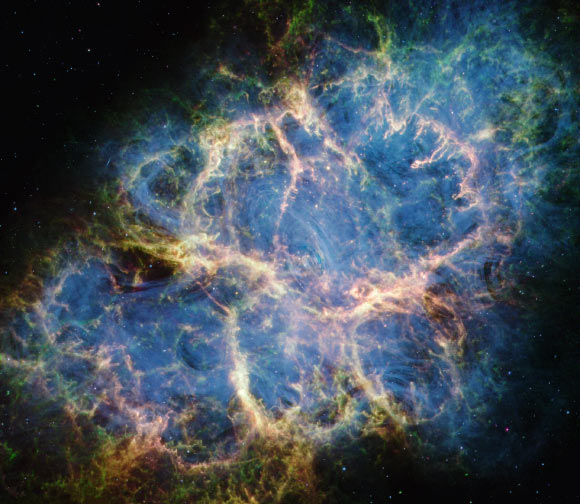The NASA/ESA/CSA James Webb Space Telescope has provided a stunning new view of the Crab Nebula, including the highest-quality infrared data yet available to aid astronomers as they explore the detailed structure and chemical composition of this supernova remnant.
Webb dissected the Crab Nebula’s structure, aiding astronomers as they continue to evaluate leading theories about the supernova remnant’s origins. Image credit: NASA / ESA / CSA / STScI / T. Temim, Princeton University.
The Crab Nebula is the result of a supernova explosion seen by Chinese, Japanese, Arabic, and Native American stargazers in 1054 CE.
Bright enough to be visible in amateur telescopes, this beautiful nebula lies 6,500 light-years away in the constellation of Taurus.
Also known as Messier 1, NGC 1952 or Taurus A, it was first identified in 1731 by the English astronomer, doctor and electrical researcher John Bevis.
In 1758, while searching for a comet, the French astronomer Charles Messier rediscovered the hazy nebula. He later added the object to his celestial catalog as Messier 1, marking it as a ‘fake comet.’
The nebula derived its name from its appearance in a drawing made by Irish astronomer Lord Rosse in 1844.
The Crab Nebula is highly unusual. Its atypical composition and very low explosion energy have previously led astronomers to think it was an electron-capture supernova — a rare type of explosion that arises from a star with a less-evolved core made of oxygen, neon, and magnesium, rather than a more typical iron core.
Past research efforts have calculated the total kinetic energy of the explosion based on the quantity and velocities of the present-day ejecta.
Astronomers deduced that the nature of the explosion was one of relatively low energy (less than one-tenth that of a normal supernova), and the progenitor star’s mass was in the range of eight to 10 solar masses — teetering on the thin line between stars that experience a violent supernova and those that do not.
However, inconsistencies exist between the electron-capture supernova theory and observations of the Crab Nebula, particularly the observed rapid motion of the pulsar.
In recent years, astronomers have also improved their understanding of iron-core-collapse supernovae and now think that this type can also produce low-energy explosions, providing the stellar mass is adequately low.
To lower the level of uncertainty about the Crab Nebula’s progenitor star and the nature of the explosion, Princeton University Tea Temim and colleagues used Webb’s spectroscopic capabilities to home in on two areas located within the Crab’s inner filaments.
Theories predict that because of the different chemical composition of the core in an electron-capture supernova, the nickel to iron (Ni/Fe) abundance ratio should be much higher than the ratio measured in our Sun, which contains these elements from previous generations of stars.
Studies in the 1980s and early 1990s measured the Ni/Fe ratio within the Crab Nebula using optical and near-infrared data and noted a high Ni/Fe abundance ratio that seemed to favor the electron-capture supernova scenario.
The Webb telescope, with its sensitive infrared capabilities, is now advancing Crab Nebula research.
The study authors used the spectroscopic abilities of Webb’s MIRI (Mid-Infared Instrument) to measure the nickel and iron emission lines, resulting in a more reliable estimate of the Ni/Fe abundance ratio.
They found that the ratio was still elevated compared to the Sun, but only modestly so and much lower in comparison to earlier estimates.
The revised values are consistent with electron-capture, but do not rule out an iron-core-collapse explosion from a similarly low-mass star.
Higher-energy explosions from higher-mass stars are expected to produce Ni/Fe ratios closer to solar abundances.
Further observational and theoretical work will be needed to distinguish between these two possibilities.
Besides pulling spectral data from two small regions of the Crab Nebula’s interior to measure the abundance ratio, Webb also observed the remnant’s broader environment to understand details of the synchrotron emission and the dust distribution.
The images and data collected by MIRI enabled the astronomers to isolate the dust emission within the Crab Nebula and map it in high resolution for the first time.
“By mapping the warm dust emission with Webb, and even combining it with data from NASA’s Herschel Space Observatory on cooler dust grains, we created a well-rounded picture of the dust distribution: the outermost filaments contain relatively warmer dust, while cooler grains are prevalent near the center,” they said.
A paper on the findings was published in the Astrophysical Journal Letters.
_____
Tea Temim et al. 2024. Dissecting the Crab Nebula with JWST: Pulsar Wind, Dusty Filaments, and Ni/Fe Abundance Constraints on the Explosion Mechanism. ApJL 968, L18; doi: 10.3847/2041-8213/ad50d1
>>> Read full article>>>
Copyright for syndicated content belongs to the linked Source : Breaking Science News – https://www.sci.news/astronomy/webb-structure-crab-nebula-13026.html
